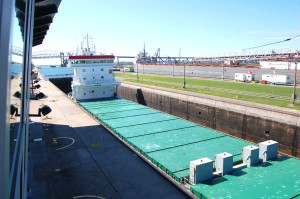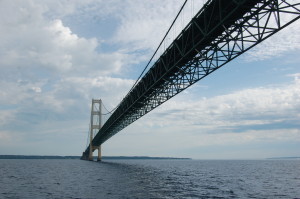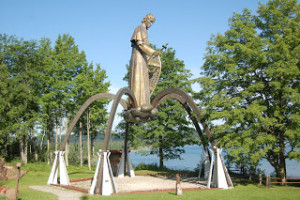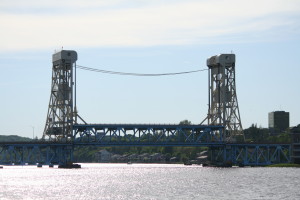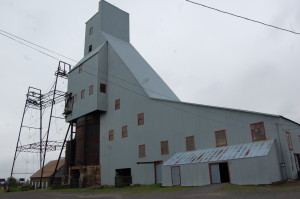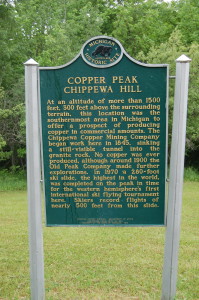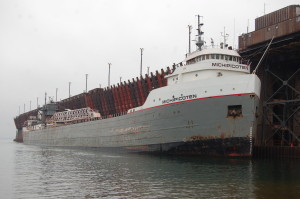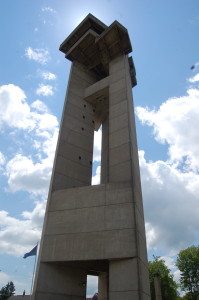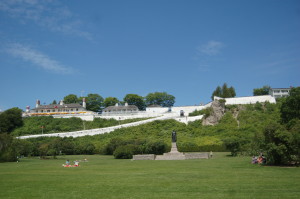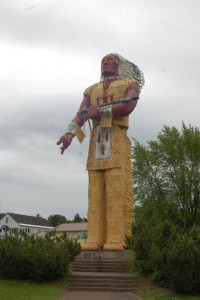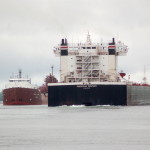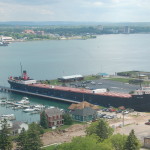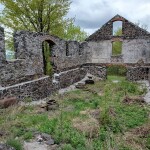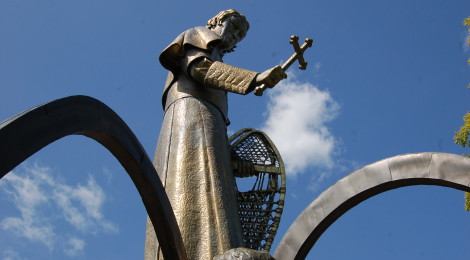
Michigan’s Top 10 Man-Made Wonders: Upper Peninsula Edition
Michigan’s Upper Peninsula is a land of incredible natural beauty, and a minimal population compared to the Lower Peninsula makes it an alluring place for travelers looking to get away from more congested areas downstate. We continue to try and provide the best information possible on the natural wonders and attractions across the state, as well as highlighting some of the newer and more modern ones. Today, we decided to share our picks for Michigan’s Top 10 Man-Made Wonders of the Upper Peninsula; a collection of engineering marvels, statues and memories of a more industrial time. Enjoy!
Soo Locks in Sault Ste. Marie – This engineering marvel allows ships to pass back and forth from Lake Superior and the lower Great Lakes via a set of parallel locks on the St. Mary’s River. Rapids on the river originally created a 21-foot difference between the two bodies of water, but the locks raise or lower ships safely to the desired water level for them to continue their journey. The Army Corps of Engineers maintains and operates an observation area here just off of Portage Ave. The Poe Lock is able to handle the 1,000 ft. and longer lake freighters, and the Locks allow ships to travel from Lake Superior to the St. Lawrence Seaway all the way out to the Atlantic Ocean.
Mackinac Bridge – This majestic bridge is a Michigan icon that connects the Lower Peninsula to the Upper Peninsula. It carries four lanes of I-75 across a more than 26,000 foot span that is the world’s 16th-longest suspension bridge. Prior to the bridge’s opening in 1957, passenger and car ferries were the only way to cross the Straits of Mackinac. The towers stick up 552 feet above the water, and cars crossing the midpoint are about 200 feet above the water. There are many ways to get a great view of the Mighty Mac, check out our top six choices here.
Baraga Shrine, L’Anse – This copper statue of Bishop Frederic Baraga rises 60 feet above a cloff overlooking the Keweenaw Bay in L’Anse. The “snowshoe priest” is depicted rising above a cloud holding snowshoes and a cross, while the four teepees that make up the statue’s base represent four of the Michigan missions he founded. Baraga was one of the early pioneers of the Upper Peninsula, and many places still bear his name. In the winter he would travel hundreds of miles on snowshoes to reach the native people, often covering 700 miles or more in a season. This sculpture was completed in the 1960s, and the shrine is open to the public for free.
Portage Lake Lift Bridge (Houghton-Hancock Bridge) – This 500-foot long bridge connects the northern and southern parts of the Keweenaw Peninsula and the communities of Houghton and Hancock. It is a double-decker bridge in which the middle section can be raised to allow ships to pass below. The Keweenaw Waterway isn’t nearly as busy today as it once was, but the bridge still sees upwards of 20,000 crossings each day on US-41/M-26.
Quincy Mine, Hancock – This mine in Hancock operated from 1846-1948, and was one of the most profitable of the many mines on the Keweenaw Peninsula. Its Number 2 shaft was at one time the world’s deepest shaft (1.75 miles) and the Number 2 Steam Hoist was the world’s largest steam-driven hoist. Ore could be lifted at 36 miles per hour with its use, which saved in operating costs and added to the mine’s profitability. Today, this is one of the Keweenaw’s mot popular tourist destinations, as the Keweenaw National Historic Park operates guided tours.
Copper Peak, Ironwood Township – This ski flying hill opened in the 1970s and is the only one of its kind in the Western Hemisphere. It hosted several competitions in its first two decades of operation and once saw a hill record jumps of 518 feet completed by Mathias Wallner and Werner Schuster of Austria. While no jumps have taken place here since 1994, the site remains open as an adventure ride that takes visitors on an 800-foot chair lift ride and then 18 stories higher via elevator for an amazing panoramic view that covers 2500 square miles, three states, and even Canada on clear days. The views get even better during fall color season. http://www.copperpeak.com/activities.html
Marquette Ore Docks – The pocket ore dock of the LS&I Railroad is located near beautiful Presque Isle Park in Marquette, and was the first dock of its kind on the upper Great Lakes. It is the only ore dock in Marquette still operating today, and freighters visit on an almost daily basis. Millions of tons of iron ore have been loaded here and shipped out to ports like Cleveland and Buffalo where it is then made in to steel. The 100th anniversary of the dock was celebrated in 2012. Some of the ships that stop by on a regular basis are the Hon. James L. Oberstar, Mesabi Miner, Michipicoten and Herbert C. Jackson.
Tower of History, Sault Ste. Marie – This tower rises 210 feet above the oldest city in Michigan and provides panoramic views of Sault Ste. Marie, the St. Mary’s River, Soo Locks and the Canadian shoreline to the north. Built in 1968, this was originally intended to be part of a larger Catholic shrine complex. It has been operated as a Sault Historic Site since 1980, and for a small fee visitors can take an elevator to the top where multiple observation decks provide stunning views. There are also historic displays on the lower and upper levels. The Tower of History is located at 326 E. Portage Ave.
Fort Mackinac, Mackinac Island – This fort was built by the British in the 1780s, and it sits atop a 150-foot limestone bluff on Mackinac Island. Two battles took place on the island during the War of 1812, and the fort remained in British hands until after the Treaty of Ghent was signed. After the fort’s military significance declined, it was opened up to visitors as the second national park in the United States. In 1895 the state of Michigan took control of the site and has operated it as a state park since. It was Michigan’s first state park, and remains one of the most visited destinations in the state thanks to its excellent restoration and preservation efforts. Visitors today can enter for a small fee, taking in the sights of 14 historic buildings, costumed interpreters, and “soldiers” demonstrating the firing of muskets and cannons. http://www.mackinacparks.com/parks-and-attractions/fort-mackinac/
Hiawatha in Ironwood – Known as the “World’s Tallest Indian,” this 52-foot-tall fiberglass statue doesn’t get the attention it deserves due to its location in Ironwood. If this was on the side of US-2, there would be countless cars stopped for the amazing photo op. Instead, curious visitors will have to travel a few blocks south to see this statue that weighs in at 16,000 pounds (with internal steelwork included) and was built to withstand winds of up to 140 miles per hour.

